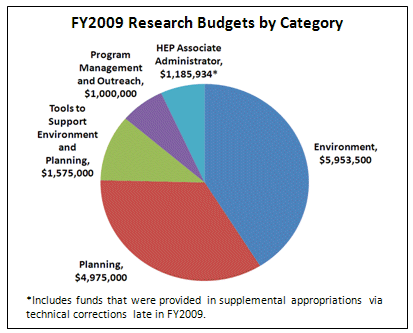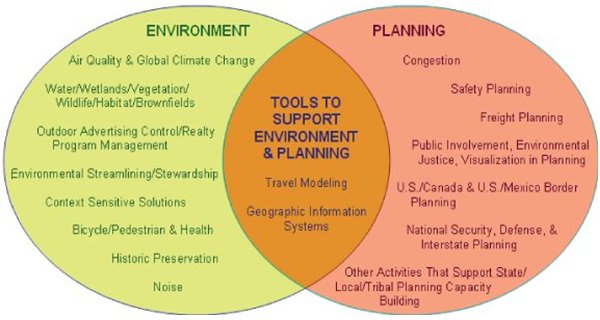2009 Annual Report
Section I: Background
The Federal Highway Administration (FHWA) Office of Planning, Environment and Realty's (HEP) Surface Transportation Environment and Planning Cooperative Research Program (STEP) ended on September 30, 2012. For current HEP research information, please see HEP's research web site.
Since 2006, the Federal Highway Administration (FHWA) has administered the Surface Transportation Environment and Planning Cooperative Research Program (STEP) to encourage new, strategic and applied research on the relationship between surface transportation planning and the environment. Federal, State, and other stakeholders are involved throughout the STEP process to shape, refine, and implement research agendas.
This publication provides an overview of the STEP program's accomplishments during Fiscal Year (FY) 2009. Detailed information about outreach activities and specific research projects can be found in the appendices.
Linking Research to Practice
STEP funding allows researchers to carry out timely investigations and analyses, translate and synthesize research from other initiatives into practice, and fund quick turn-around efforts that advance key strategies to address national priorities.
 |
*Includes funds that were provided in supplemental apprpriations via technical corrections late in FY 2009.
Figure 1: FY2009 Research Budgets by Category |
STEP funds support projects with three different, but interrelated functions:
- Conducting Research Studies - Several projects collect and analyze scientific or technical data about species and habitat, construction materials, travel patterns, and other topics. Researchers in academia, at State DOTs, or in other State agencies carry out this work to create a foundation for applied projects that implement findings and new practices.
- Developing and Deploying Tools, Technologies and Practices - Many projects build on the technical and scientific foundation established by STEP-funded projects. These activities translate research findings into action though the establishment of demonstration and pilot programs, the documentation of best practices, and other activities.
- Connecting the Community and Transferring Knowledge - Other projects facilitate dialogue and links among transportation professionals. National associations and Federal, State, and local agencies host peer exchanges, summits, conferences, and similar events. They also develop training materials, build websites, and partner with stakeholders to share critical information.
STEP's Legislative History
Section 5207 of the Safe, Accountable, Flexible Efficient Transportation Equity Act: A Legacy for Users (SAFETEA-LU) established the STEP program for 2006-2009. Congress mandated a 50 percent non-Federal match to encourage collaboration with partners and increase the scope of research that can be undertaken. In cases where projects are funded through a competitive bid process, the requirement may be waived.
Efficient Management of a Successful Program
SAFETEA-LU authorized $16.875 million annually to implement the STEP. After adjusting for obligation limitations, rescissions and the over-designation of Title V Research in SAFETEA-LU, $14.5 million was available for the FY2009 STEP.
Through STEP, FHWA invests in projects in 17 "emphasis areas" that fall into three broad research categories: environment, planning, and tools to support environment and planning (see figures). The 67 projects funded in FY2009 enhance the state-of-the-art and practice in planning, environment, and realty.
STEP Emphasis Areas

Figure 2: STEP Emphasis Areas
Highlights of FY2009 STEP Research
STEP projects include short-term initiatives and ongoing multi-year programs; they may be carried out by FHWA staff, or by a collection of professionals in many different agencies. The FHWA uses STEP funds and the STEP process to build partnerships that encourage collaboration, leverage diverse funding sources, and offer a fresh perspective on emerging research topics. FY2009 STEP projects reflect stakeholder feedback and collaboration.
Notable projects from each emphasis area are highlighted below with respect to their core function:
Conducting Research Studies
- Investigated driver attention issues and potential risks to safety through field measurements of driver behavior.
- Analyzed economic impacts of travel time at international border points of entry and evaluated cross-border travel to improve information exchange and traffic forecasting.
- Assessed and documented methodologies, best practices, and innovations on a wide variety of transportation project and planning topics, including contracting practices, environmental mitigation, and megaregions.
- Evaluated the impact of investing in bicycling and walking infrastructure and programs on travel behavior, energy consumption, physical activity, and environmental quality as part of the Nonmotorized Transportation Pilot Program.
Developing and Deploying Tools, Technologies and Practices
- Created a decision-support tool to evaluate the potential for large-scale carbon sequestration activities in several States.
- Improved state-of-the-art highway traffic noise prediction and noise barrier design model based on input from the user community.
- Disseminated information on transportation applications of geospatial technologies through peer exchanges, case studies, and a quarterly webcast series.
- Developed multiple tools to improve the quality and efficiency of environmental decision-making, including publication of a monthly environmental streamlining newsletter.
- Produced multiple reference guidebooks to promote the integration of freight in the transportation planning and programming processes at the State and metropolitan levels.
- Improved National Highway System network data and maps.
- Conducted webinars and peer reviews to provide travel modeling technical assistance to transportation stakeholders.
Connecting the Community and Transferring Knowledge
- Facilitated workshop with 11 Federally recognized Native American Tribes to discuss and share multicultural approaches to intergovernmental communication, consultation, and cooperation.
- Collaborated with the American Association of State Highway and Transportation Officials (AASHTO) and the Federal Transit Administration (FTA) to document and share strategies with State Departments of Transportation (DOTs) on coordinating planning and operations activities.
- Conducted a domestic scan tour to document and disseminate best management practices in addressing water quality issues in highway system management.
- Compiled noteworthy practices, updated reference material, and identified performance measures to build State DOTs' and metropolitan planning organizations' (MPOs) capacity in safety planning.
- Promoted effective statewide, metropolitan, rural and tribal transportation planning practices through nationwide Transportation Planning Capacity Building Program events.
- Implemented a workshop series and developed several publications to share effective professional practices related to Context Sensitive Solutions, including applications and programs from around the country.
"This is an excellent program to identify research and training needs."
- Arizona Department of Transportation stakeholder |
Stakeholder outreach, feedback, and participation in research efforts are critical to successful implementation of the STEP. Throughout FY2009, FHWA collaborated with Federal, Tribal, and State partners, representatives of national associations, members of the academic community, private sector professionals, and individual citizens. Together they assessed research needs, identified potential funding sources, and designed appropriate research plans and activities. For the past four fiscal years, FHWA has also collected stakeholder feedback through a Web-based system. Using this system, stakeholders can target their feedback towards one of the 17 emphasis areas or submit general comments. Additionally, hundreds of individuals were reached through email communication or meetings, conferences, and other events.
